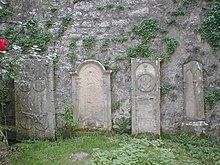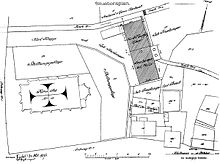Evangelical Church of Fürfeld
The Evangelical Church in Fürfeld , a district of Bad Rappenau in the Heilbronn district in northern Baden-Württemberg , was built in the neo-Gothic style in 1871/73 .
history
Previous construction
A church in Fürfeld had existed since the 13th or 14th century and was dedicated to the Holy Cross. Through the commitment of the Fürfeld local lord Philipp von Gemmingen for the cause of the Reformation , Fürfeld was reformed in 1521 with the appointment of the evangelical pastor Martin Germanus. The old church was in the center of the village next to the old rectory , had received a new tower in 1712, but in 1769 it was again in need of major renovation. The considerations for a new building and the establishment of a church building fund go back to the 1780s. However, the construction plans dragged on for several decades because the financing of a new building was initially unclear. The local rule was over-indebted in the second half of the 18th century and the place was under compulsory administration of the knightly canton Kraichgau . After the repeal of the imperial knighthood, the municipal finances remained desolate due to the high taxes of the war years 1806 to 1814. In a trial from 1841 to 1845 before the civil senate of the royal court in Esslingen, the community also tried to shift the construction burden on to the barons of Gemmingen as church patrons and landlords, but this was rejected by the civil senate. In the meantime, the tower of the old church had to be demolished in 1841 because it was dilapidated. From 1843 the pastor's post was only occupied by a parish administrator, so that the old rectory was sold to the community in 1844 and converted into a poor house. A place for a new church was not found until 1869. After the completion of the new church building, the old church was sold to a farmer, converted into a barn in 1874 and demolished around 1972. Some historical tombs and other stones from the old church were brought to Fürfeld Castle .
New church building 1871/73
After initially considering building a new church on the square by the Gasthaus Ochsen , the community acquired the former post office building on Heilbronner Strasse outside the town center on December 7, 1869 . The postal estate included a barn, fields and a quarry. The post office was rebuilt in 1849 after fire and served as a rectory from 1870. The church was built on the surrounding open space, with some of the stones needed to build the church being extracted from the associated quarry. The plans for the church were made by the Heilbronn building officer Albert Barth . Paul Burkhardt designed the stone spire and a neo-Gothic pulpit . The construction of the church began in 1871 and was completed with the inauguration of the building in October 1873.
The organ of the church was built by Christoph Ludwig Goll in Kirchheim unter Teck. Many of the church's furnishings were donated by the von Gemmingen family . The Heilbronn chief magistrate Karl von Gemmingen donated a glass window for the choir, which shows the birth of Christ, as well as various devices for the Lord's Supper. Ernst and Franz von Gemmingen donated baptismal devices, other members of the family donated further liturgical devices.
After the Second World War, the church was greatly simplified through several modifications. Instead of the spire made of sandstone tracery, the church tower was given a tiled roof in 1951 according to plans by Hannes Mayer , and the pinnacles that were once outside the church were removed and three new bells were purchased. In 1961/62 the church was renovated inside, whereby almost the entire neo-Gothic interior (galleries, pulpit, wooden vaulted ceiling, baptismal font) was removed. In the course of this renovation, the church received three new choir windows by Peter Jakob Schober and a two-manual organ with 14 registers by Walcker .
In 1970 a new rectory was built next to the church, whereupon the old rectory was sold.
In 1987 a community hall, tea kitchen and toilets were built into the church. In 1988 the church received a Christ relief made of terracotta and wooden planks by Reinhard Siecke . The last major renovation of the church took place in 2004, when the steel bell cage was replaced with a wooden one and two more bells were hung by the Bachert bell foundry.
description
architecture
The Evangelical Church of Fürfeld is a single-nave hall church with a choir built to the east and a tower protruding from the west gable. The church building is 22 meters long and 14 meters wide. There are 630 seats in the interior, of which around 190 are on the gallery .
The choir of the church is adorned with three glass windows by Peter Jakob Schober , which show scenes from the Old and New Testament. The old choir window with the Nativity was inserted into a window on the north side of the church.
Bells
As early as 1866 , the parish had procured a bronze bell cast at Knittel in Cannstatt . This bell had a diameter of 85 cm and a weight of 380 kg. Her inscription read PRAISE HIM ON HIGH PSALM. 148.1. When the church was rebuilt in 1873, this bell was taken out of service for the time being and three new bells were procured at the Bachert bell foundry in Kochendorf ( Bad Friedrichshall ). The largest of these bells had the strike tone f sharp ', a diameter of 103 cm and a weight of 658 kg. Her inscription read HONOR TO GOD ON HEIGHT & PEACE ON EARTH & PLEASURE TO PEOPLE. The middle bell had the striking note b ', a diameter of 86 cm and a weight of 375 kg. The smallest bell had a c sharp '' strike, a diameter of 67 cm and a weight of 175 kg.
During the First World War, the largest and the smallest of the bells from 1873 had to be delivered for armament purposes in 1917. The middle bell was still there in 1920. In the late 1920s, the three-bell ringing of the church consisted of the old bell from 1866, which was put back into service, and a bronze bell cast by Bachert in Kochendorf (Bad Friedrichshall) in 1922 with the strike tone c '', a diameter of 75 cm and a weight of 236 kg with the inscription GOD IS OUR CONFIDENCE AND STRENGTH. PSALM 46.2. as well as a bronze bell cast in 1926 by Heinrich Kurtz in Stuttgart with the strike tone g ', a diameter of 103 cm and a weight of 657 kg with the inscription DEIN REICH KOMME. FROM DEEP EMERGENCY I SCREAM TO YOU. LORD GOD, LISTEN TO MY CALL.
In the Second World War, bells had to be delivered again, so that only the bell from 1922 remained in Fürfeld. In 1951 a new triple bell was cast at Kurtz in Stuttgart, in which the bell from 1922 was cast as a casting. The largest of the bronze bells, the prayer bell , has the striking tone g ', a diameter of 103.4 cm and a weight of 657 kg. Their inscription reads YOUR NAME BE SANCTIFIED . The middle bell, the cross bell , has the striking note b ', a diameter of 86.4 cm and a weight of 391 kg. Its inscription reads HE IS OUR PEACE. The smallest of the bells, the baptismal bell , strikes c '', is 76.7 cm in diameter and weighs 273 kg. Their inscription reads HE MUST GROW, BUT I HAVE TO LOOSE. The bell was electrified in 1961.
In 2004 a new bell cage was installed and the chime was extended to include the Dominika bell and the blessing bell . Both were cast by Bachert in Karlsruhe. Dominika has the strike note f ', a diameter of 116.1 cm and a weight of 892 kg. It bears a longer inscription and is decorated with numerous symbols and decorative elements. The blessing bell has the strike tone d '', a diameter of 69.9 cm and a weight of 218 kg. It also bears a longer inscription and is also richly decorated.
literature
- Hannes Wössner: Evangelical Church Fürfeld. In: Matthias Driver (ed.): The Protestant churches in the Heilbronn church district. Evangelical Church District Heilbronn, Heilbronn 2005, pp. 14–15
- Fürfeld - from the past and present of the former imperial knighthood town . City of Bad Rappenau, Bad Rappenau 2001, ISBN 3-929295-77-6
- Julius Fekete : Art and cultural monuments in the city and district of Heilbronn . 2nd Edition. Theiss, Stuttgart 2002, ISBN 3-8062-1662-2 , p. 93.
- Norbert Jung: Immaculata - A contribution to the history of bells in Bad Rappenau , in connection with the Bad Rappenau town archive, ed. by Norbert Jung, Heilbronn 2010, pp. 26–30.
Web links
Coordinates: 49 ° 12 ′ 34.9 ″ N , 9 ° 3 ′ 27 ″ E



